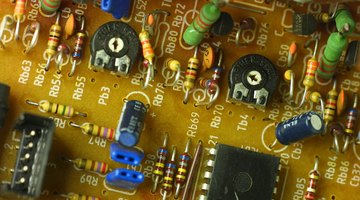Troubleshooting Lennox Circuit Boards
A Lennox circuit board controls the main functions of an HVAC unit. It comes equipped with two LED lights that help you troubleshoot what may be wrong with the board's controls or the HVAC system. Lennox manufactures two main types of circuit boards, depending on the model of the HVAC system.

Both types of boards use identical diagnostic codes to simplify the troubleshooting process.
Things You Will Need
- Flat-head screwdriver
- List of Lennox LED diagnostic codes
-
Place the HVAC unit's thermostat at a temperature that causes the unit to ignite. Make sure the furnace's power switch is turned off prior to opening the board's door. Locate the circuit board door on the HVAC system. Look for a plate with a sticker bearing the Lennox name. Remove the screws holding the plate or door in place with a flat-head screwdriver. Locate both LED lights on the circuit board and determine which functions as the first light and the second light.
-
Observe whether either light is off or on. Determine if one or both of the lights are flashing and whether the flashes are fast, slow, alternating or simultaneous. Match up what each LED light is doing with Lennox's diagnostic code table. For example, if the first light is giving off a slow flash and the second light provides steady illumination, this could indicate a problem with the primary or secondary voltage limit.
-
Consult the list of diagnostic codes to determine the root cause of the HVAC system's failure. Consult the description provided in the diagnostic code table to determine a potential fix and what a technician may need to repair. For example, a slow flash from the first LED light and a fast flash from the second LED light often indicates a problem with a low flame signal. In this case, a technician would need to replace the system's flame sense rod.
-
Write down the results of the circuit board diagnostics. Screw the board's plate door back onto the front of the HVAC system with the flat-head screwdriver. Restore power to the HVAC system. Decide whether the necessary repairs need a professional technician or are within the realm of the homeowner's expertise. Call the electric company if the problem is the amount of voltage that the building's electric lines receive.
Tip
LED lights on a good circuit board and properly working system will illuminate a simultaneous slow or fast flash.
Warning
Make sure the power is not on prior to examining or opening up any part of the HVAC system. Electrical shock is a potential consequence. Make sure all tools are grounded prior to opening up the unit. Failure to diffuse potential electrical shock from outside objects could damage the unit and the circuit board.
The Drip Cap
- A Lennox circuit board controls the main functions of an HVAC unit.
- It comes equipped with two LED lights that help you troubleshoot what may be wrong with the board's controls or the HVAC system.
- For example, if the first light is giving off a slow flash and the second light provides steady illumination, this could indicate a problem with the primary or secondary voltage limit.
- Consult the list of diagnostic codes to determine the root cause of the HVAC system's failure.
- Screw the board's plate door back onto the front of the HVAC system with the flat-head screwdriver.
References
Writer Bio
Helen Akers specializes in business and technology topics. She has professional experience in business-to-business sales, technical support, and management. Akers holds a Master of Business Administration with a marketing concentration from Devry University's Keller Graduate School of Management and a Master of Fine Arts in creative writing from Antioch University Los Angeles.
Photo Credits
- Photos.com/Photos.com/Getty Images
- Photos.com/Photos.com/Getty Images
More Articles



